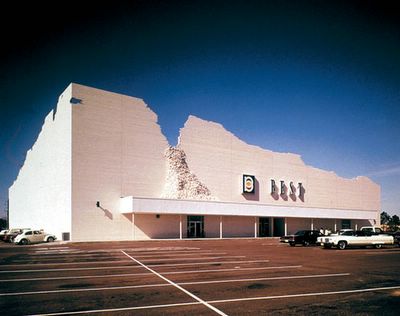
The Best Products Co. Indeterminate Facade building in Houston blends prototypical big-box features with a brick facade that appears to be simultaneously undergoing construction and demolition. It is currently empty.
Courtesy SITE Projects Inc.
The Best Products showrooms were Post-Modern icons, giving the suburbs their own landmark architecture. An admirer asks, "Where are they now?"
By James McCown
Metropolis Magazine
Before big-box retailing even had a name, James Wines was taking the box and turning it on its side, extruding its facade, even making it appear to crumble. The New York-based architectural designer and sculptor was cofounder with Alison Sky of SITE, a design firm that changed forever how we think about suburban retail with its series of Best Products showrooms, built between 1972 and 1984. The buildings drew interest far and wide: to locals they were curiosities, visual points of reference in suburban wastelands seemingly desperate for any sense of place; to the artistic elite they were Dadaist works worthy of Duchamp, winking comments on everything from consumer culture to the increasingly fractured nature of American life.
But these buildings-as-sculpture in Wal-Mart country were not to last. Best Products Company, an appliance and housewares catalog retailer, folded in the mid-1990s. Of the nine showrooms SITE built, all but two have either been torn down or stripped of their architectural witticisms. What's left of the Peeling Project in Richmond, Virginia, its front elevation now just a blank wall, houses a weekend flea market and pawn shop heralding "Top $ for Your Gold." The Tilt Building in Towson, Maryland, an engineering marvel whose 450-ton masonry-block facade seemed to balance precariously on one corner, was razed completely and the site redeveloped. Buildings in Miami and Milwaukee were retrofitted into a Sears and a Wal-Mart, respectively. The Notch Project in Sacramento and Water Showroom in Hialeah, Florida, also lost their absurdist touches to become traditional big-box venues. (article continues)

The Indeterminate Facade building today.
UPDATE: Panoramic shot of Indeterminate Facade

In April, 2002, Diebold Essen went to the site with his digital camera, stood on the edge of the parking lot, and turned 360 degrees, snapping away. On the next page, you can see the result: Indeterminate Facade Showroom, well into its third decade, before its destruction, in context.
No comments:
Post a Comment